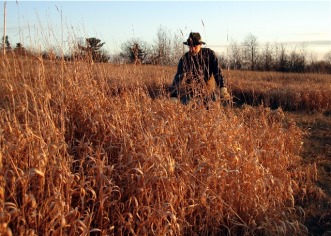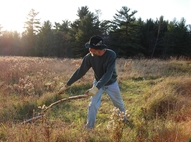|
In 2006 I attended the International Scythe Symposium, hosted by the Vido family on their farm in New Brunswick, Canada. The event was a delight for a photographer. I took a lot of pictures. I had posted some of them in the photo gallery on my farm website before, but in an awkward format. Since it's still winter here, and there's not a whole lot of mowing going on, I thought I'd revisit the Symposium with this blog, and re-post the pictures with the great multimedia features of this Wordpress blog. The slide show above is of the mowing workshops at the Symposium. Hope you enjoy it. Please comment and feel free to ask questions. I will add more text and photos over time.
0 Comments
First let's start with how NOT to mow with a scythe. I hope Enne doesn't mind, but this video is such a typical example of how most people instinctively swing a scythe, that I would like to utilize it for educational purposes. Most beginners swing the scythe through the air, and slash and hack at the tall grass and weeds, just like in the above video. This would be fine with a primitive scythe, like the Japanese scythe (more of a long handled sickle), but with the more sophisticated Austrian scythe that she is using here, she is wasting a lot of energy, and could very easily damage the thin metal edge of her blade. The Austrian scythe is a very sophisticated mowing tool. I say it over and over again; the Austrian scythe blade has 3 curves. The slashing and hacking that most people want to do with a scythe, would only require one curve: the crescent shape. The Austrian scythe blade has three curves for a reason. Form = Function. The three curves (which I call the crescent, the rocker, and the belly) enables the blade to slide over the ground, without the tip or the cutting edge, hitting the dirt. The rocker enables the blade to slide over the ground, without tip digging into the dirt. The belly enables the cutting edge to stay off the ground, when it's sliding forward on its belly.
Don't put your scythes away for the season just yet! Now is a great time of year to mow tall dry grasses for use as animal bedding, garden mulch, or dry matter for compost piles. Reed Canary grass is my favorite dry grass. It's easy to mow and yields a tremendous volume of straw. At this time of year, the seeds have all fallen off, and since it's a dominant monoculture, there aren't many other plants mixed in, so it makes a great seed-free mulch. When harvested in dry weather, it requires no further drying, and you can put it directly in a haystack, or pile it high in your barn or chicken coop for winter bedding. The big hollow stems are great for keeping air in a compost pile. So after you use it for bedding, the manure and straw mix is very compostable. It doesn't form a dense anaerobic mass (like hay or leaves do), that takes forever to break down. The video below shows how I mow Reed Canary Grass: This next video shows how we bring the Reed Canary grass straw in from the field. I don't have a real barn here yet, so I store the straw on my Pyramid Haystack frame next to my goose house, and cover it with a tarp. In the winter, it's easy to take off the tarp, and pull off as much straw as I need for bedding at a time for my geese, and then cover the stack back up again. |
Botan AndersonArchives
March 2023
Categories
All
|


 RSS Feed
RSS Feed